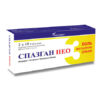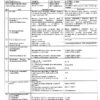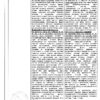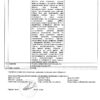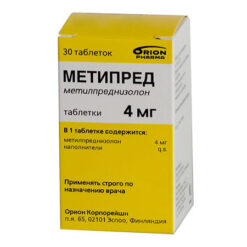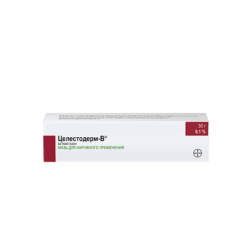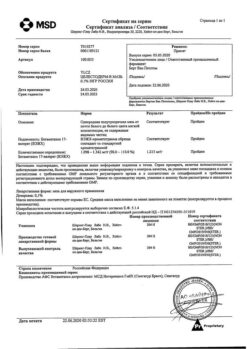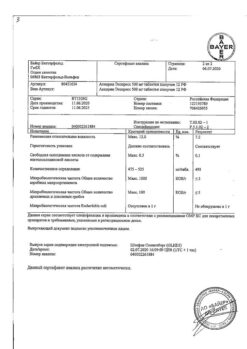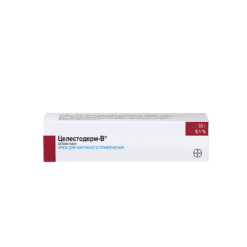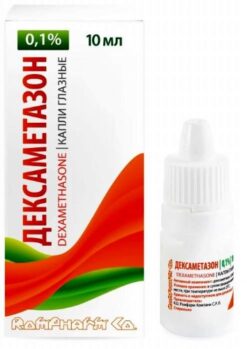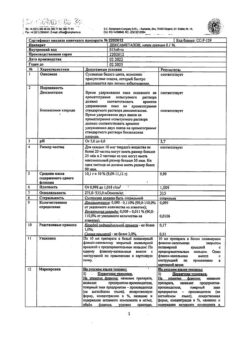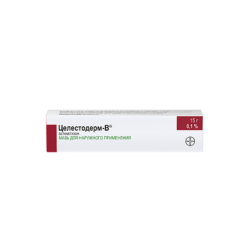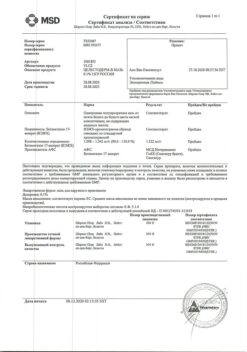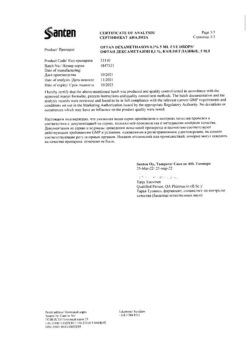No products in the cart.
Spazgan Neo, 400 mg+5 mg+0.1 mg 20 pcs
€9.02 €7.89
Description
Combined drug, has analgesic, anti-inflammatory and antispasmodic effect. Inhibits the synthesis of prostaglandins (Pg). The composition of the drug includes non-steroidal anti-inflammatory agent ibuprofen, myotropic antispasmodic agent pitofenone hydrochloride and m-cholin blocking agent of central and peripheral action fenpiveryinia bromide.
Ibuprofen is a derivative of phenylpropionic acid. It has analgesic, anti-inflammatory and antipyretic effects. The main mechanism of action is inhibition of prostaglandin biosynthesis – modulators of pain sensitivity, thermoregulation and inflammation in the central nervous system and peripheral tissues. In women with primary dysmenorrhea it decreases the increased level of prostaglandins in myometrium thus reducing intrauterine pressure and frequency of uterine contractions.
Pitophenone hydrochloride, similarly to papaverine, has a direct myotropic effect on smooth muscles of internal organs and causes its relaxation. Phenpiverinia bromide due to its m-cholinoblocking action has an additional relaxing effect on the smooth muscles. The combination of the three drug components leads to the mutual enhancement of their pharmacological action.
Pharmacokinetics
The drug components SPAZGAN NEO are well absorbed in the gastrointestinal tract. Peak plasma concentrations are reached approximately 1-2 hours after drug administration. The main component of the drug ibuprofen is 99% bound to plasma proteins, may accumulate in synovial fluid, is metabolized in the liver and excreted 90% in the urine as metabolites and conjugates. A small part of the drug is excreted with bile. Blood plasma elimination half-life is 2 hours.
Indications
Indications
– Mild and moderate pain syndrome due to spasms of smooth muscles of internal organs: renal and biliary colic, biliary dyskinesia, intestinal colic.
– Gynecological diseases: dysmenorrhea.
– Headache, including migraine type.
– Short-term symptomatic treatment for joint pain, neuralgia, sciatica, myalgia.
Pharmacological effect
Pharmacological effect
The combined drug has analgesic, anti-inflammatory and antispasmodic effects. Suppresses the synthesis of prostaglandins (Pg). The composition of the drug includes the non-steroidal anti-inflammatory drug ibuprofen, the myotropic antispasmodic drug pitofenone hydrochloride and the m-anticholinergic drug of central and peripheral action fenpiverinium bromide.
Ibuprofen is a derivative of phenylpropionic acid. It has analgesic, anti-inflammatory and antipyretic effects. The main mechanism of action is inhibition of the biosynthesis of prostaglandins – modulators of pain sensitivity, thermoregulation and inflammation in the central nervous system and peripheral tissues. In women with primary dysmenorrhea, it reduces the increased level of prostaglandins in the myometrium, thereby reducing intrauterine pressure and the frequency of uterine contractions.
Pitophenone hydrochloride, like papaverine, has a direct myotropic effect on the smooth muscles of internal organs and causes its relaxation. Phenpiverinium bromide, due to its m-anticholinergic effect, has an additional relaxing effect on smooth muscles. The combination of the three components of the drug leads to a mutual enhancement of their pharmacological action.
Pharmacokinetics
The components of the drug SPAZGAN NEO are well absorbed in the gastrointestinal tract. Peak plasma concentrations are reached approximately 1-2 hours after taking the drug. The main component of the drug, ibuprofen, is 99% bound to plasma proteins, can accumulate in synovial fluid, is metabolized in the liver and is excreted 90% in the urine in the form of metabolites and conjugates. A small part of the drug is excreted in bile. The half-life from blood plasma is 2 hours.
Special instructions
Special instructions
With long-term use, monitoring of the peripheral blood picture and the functional state of the liver and kidneys is necessary.
To reduce the risk of developing adverse events from the gastrointestinal tract, the minimum effective dose should be used. When symptoms of gastropathy appear, careful monitoring is indicated, including esophagogastroduodenoscopy, a blood test with determination of hemoglobin and hematocrit, and a stool test for occult blood.
If it is necessary to determine 17-ketosteroids, the drug should be discontinued 48 hours before the study.
During treatment you should refrain from drinking alcohol.
The influence of a medicinal product for medical use on the ability to drive vehicles and machinery
During the treatment period, the patient should refrain from engaging in potentially hazardous activities that require increased concentration and speed of psychomotor reactions.
Active ingredient
Active ingredient
Ibuprofen, Pitophenone, Fenpiverinium bromide
Composition
Composition
Active ingredients: ibuprofen 400.0 mg, pitofenone hydrochloride 5.0 mg, fenpiverinium bromide 0.1 mg.
Excipients: corn starch 88.0 mg, microcrystalline cellulose 85.9 mg, sodium carboxymethyl starch (type A) 14.7 mg, alginic acid 10.6 mg, disodium edetate dihydrate 0.6 mg, povidone (PVP K-90) 11.0 mg, colloidal silicon dioxide (Aerosil 200) 7.0 mg, croscarmellose sodium 4.7 mg, sodium lauryl sulfate 2.4 mg, magnesium stearate 5.0 mg, talc 5.0 mg.
Excipients (shell): opadry II 85668918 white 19.2 mg: polyvinyl alcohol 7.4 mg, titanium dioxide 5.76 mg, talc 3.36 mg, macrogol 2.1 mg, soy lecithin 0.58 mg.
Contraindications
Contraindications
Hypersensitivity to any of the ingredients included in the drug; erosive and ulcerative changes in the mucous membrane of the stomach or duodenum, active gastrointestinal bleeding; inflammatory bowel diseases in the acute phase, including ulcerative colitis; anamnestic data on an attack of bronchial obstruction, rhinitis, urticaria, after taking acetylsalicylic acid or another non-steroidal anti-inflammatory drug – NSAID (complete or incomplete acetylsalicylic acid intolerance syndrome – rhinosinusitis, urticaria, polyps of the nasal mucosa, bronchial asthma); liver failure or active liver disease; renal failure (creatinine clearance less than 30 ml/min), progressive kidney disease; confirmed hyperkalemia; hemophilia and other bleeding disorders including hypocoagulation), hemorrhagic diathesis; period after coronary artery bypass surgery; acute intermittent porphyria; granulocytopenia; hematopoietic disorders; deficiency of glucose-b-phosphate dehydrogenase; tachyarrhythmia; angle-closure glaucoma; optic nerve diseases; prostatic hyperplasia; intestinal obstruction; pregnancy and breastfeeding, age up to 16 years.
With caution
Older age, congestive heart failure, cerebrovascular disease, arterial hypertension, coronary heart disease, dyslipidemia, hyperlipidemia, diabetes mellitus, peripheral arterial disease, nephrotic syndrome, creatinine clearance less than 30-60 ml/min, hyperbilirubinemia, gastric and duodenal ulcer (history), presence of Helicobacter pylori infection, gastritis, enteritis, colitis, long-term use of NSAIDs, blood diseases of unknown etiology (leukopenia, anemia), smoking, frequent alcohol consumption (alcoholism), severe somatic diseases, concomitant therapy with the following drugs: anticoagulants (for example, warfarin), antiplatelet agents (for example, acetylsalicylic acid, clopidogrel), oral glucocorticosteroids (for example, prednisolone), selective serotonin reuptake inhibitors (eg, citalopram, fluoxetine, paroxetine, sertraline).
Side Effects
Side Effects
The incidence of side effects is classified according to the recommendations of the World Health Organization: characterized as very common – at least 10%; often – at least 1%, but less than 10%; infrequently – not less than 0.1%, but less than 1%; rarely – not less than 0.01%, but less than <0.1%; very rarely, including individual messages - less than 0.01%.
In recommended doses, SPAZGAN NEO does not cause side effects.
From the digestive system: often – NSAID gastropathy (abdominal pain, nausea, vomiting, heartburn, loss of appetite, diarrhea, flatulence, constipation; infrequently – ulcerations of the mucous membrane of the gastrointestinal tract, which, in some cases, are complicated by perforation and bleeding; irritation and dryness of the oral mucosa, pain in the mouth, ulceration of the mucous membrane gums, aphthous stomatitis, very rarely – pancreatitis, hepatitis, liver dysfunction, hepatotoxicity.
From the respiratory system: rarely – shortness of breath, bronchospasm.
From the senses: hearing impairment: rarely – hearing loss, ringing or tinnitus; visual impairment; uncommon – blurred visual perception, scotoma, dryness and irritation of the eye, swelling of the conjunctiva and eyelids (allergic origin), amblyopia, very rarely – accommodation paresis, toxic damage to the optic nerve.
From the central and peripheral nervous system: infrequently – headache, dizziness, insomnia, anxiety, nervousness and irritability, psychomotor agitation, drowsiness, depression, very rarely – confusion, hallucinations, aseptic meningitis (more often in patients with autoimmune diseases).
From the cardiovascular system: infrequently – tachycardia, increased blood pressure; rarely – heart failure.
From the urinary system: infrequently – nephrotic syndrome (edema), oliguria, anuria, polyuria, proteinuria, cystitis, red staining of urine; rarely – acute renal failure, allergic nephritis.
Allergic reactions: infrequently – skin rash (usually erythematous or urticaria), skin itching, very rarely – angioedema, anaphylactoid reactions, anaphylactic shock, bronchospasm or dyspnea, fever, erythema multiforme exudative (including Stevens-Johnson syndrome), toxic epidermal necrolysis (Lyell’s syndrome), allergic rhinitis.
From the hematopoietic organs: infrequently – thrombocytopenia and thrombocytopenic purpura, very rarely – anemia (including hemolytic, aplastic), agranulocytosis, leukopenia, eosinophilia.
Other: very rarely – increased or decreased sweating.
From the laboratory parameters: bleeding time (may increase), serum glucose concentration (may decrease), creatinine clearance (may decrease), hematocrit or hemoglobin (may decrease), serum creatinine concentration (may increase), liver transaminase activity (may increase).
If the drug causes a change in your usual condition, stop taking it and call your doctor immediately.
Interaction
Interaction
In therapeutic doses, SPAZGAN NEO does not interact significantly with commonly used drugs.
Inducers of microsomal oxidation enzymes in the liver (phenytoin, ethanol, barbiturates, flumecinol, rifampicin, phenylbutazone, tricyclic antidepressants) increase the production of hydroxylated active metabolites, increasing the risk of severe intoxication.
Microsomal oxidation inhibitors reduce the risk of hepatotoxicity.
Reduces the hypotensive activity of vasodilators and the natriuretic effect of furosemide and hydrochlorothiazide.
Reduces the effectiveness of uricosuric drugs. Strengthens the effect of indirect anticoagulants, antiplatelet agents, fibrinolytics (which increases the risk of bleeding).
Increases the side effects of mineralocorticosteroids, glucocorticosteroids (increases the risk of gastrointestinal bleeding), estrogens, ethanol. When used simultaneously with hypoglycemic agents for oral administration, it may enhance their effect, thereby increasing the risk of hypoglycemia.
Antacids and cholestyramine reduce the absorption of ibuprofen.
Increases the blood concentration of digoxin, lithium and methotrexate.
Enhances the effect of M-anticholinergic blockers, H1-histamine blockers, butyrophenones, phenothiazines, amantadine and quinidine.
Concomitant administration of other NSAIDs increases the incidence of side effects.
Caffeine enhances the analgesic (pain-relieving) effect.
When administered simultaneously, it reduces the anti-inflammatory and antiplatelet effect of acetylsalicylic acid (it is possible to increase the incidence of acute coronary insufficiency in patients receiving small doses of acetylsalicylic acid as an antiplatelet agent after starting to take the drug SPAZGAN NEO.
Cefamandole, cefoperazone, cefotetan, valproic acid, plicamycin increase the incidence of hypoprothrombinemia when administered simultaneously.
Myelotoxic drugs increase the manifestations of hematotoxicity of the drug.
Cyclosporine and gold preparations enhance the effect of ibuprofen on the synthesis of prostaglandins in the kidneys, which is manifested by increased nephrotoxicity. Ibuprofen increases the plasma concentration of cyclosporine and the likelihood of developing its hepatotoxic effects.
Drugs that block tubular secretion reduce excretion and increase plasma concentrations of ibuprofen.
Overdose
Overdose
Do not exceed the indicated dose. If you have exceeded the dose, contact your doctor or the nearest medical facility immediately. Take the drug package with you.
Symptoms: abdominal pain, nausea, vomiting, lethargy, drowsiness, depression, headache, tinnitus, metabolic acidosis, coma, acute renal failure, decreased blood pressure, bradycardia, tachycardia, atrial fibrillation, respiratory arrest.
Treatment: gastric lavage (only within an hour after administration), activated charcoal, alkaline drinking, forced diuresis, symptomatic therapy (correction of acid-base status, blood pressure). There is no specific antidote.
Storage conditions
Storage conditions
In a dry place, protected from light, at a temperature not exceeding 25 °C.
Keep out of the reach of children!
Shelf life
Shelf life
3 years.
Manufacturer
Manufacturer
Wockhardt Ltd, India
Additional information
| Shelf life | 3 years. |
|---|---|
| Conditions of storage | In a dry, light-protected place at a temperature no higher than 25 ° C. Keep out of reach of children! |
| Manufacturer | Wockhardt Ltd, India |
| Medication form | pills |
| Brand | Wockhardt Ltd |
Related products
Buy Spazgan Neo, 400 mg+5 mg+0.1 mg 20 pcs with delivery to USA, UK, Europe and over 120 other countries.





